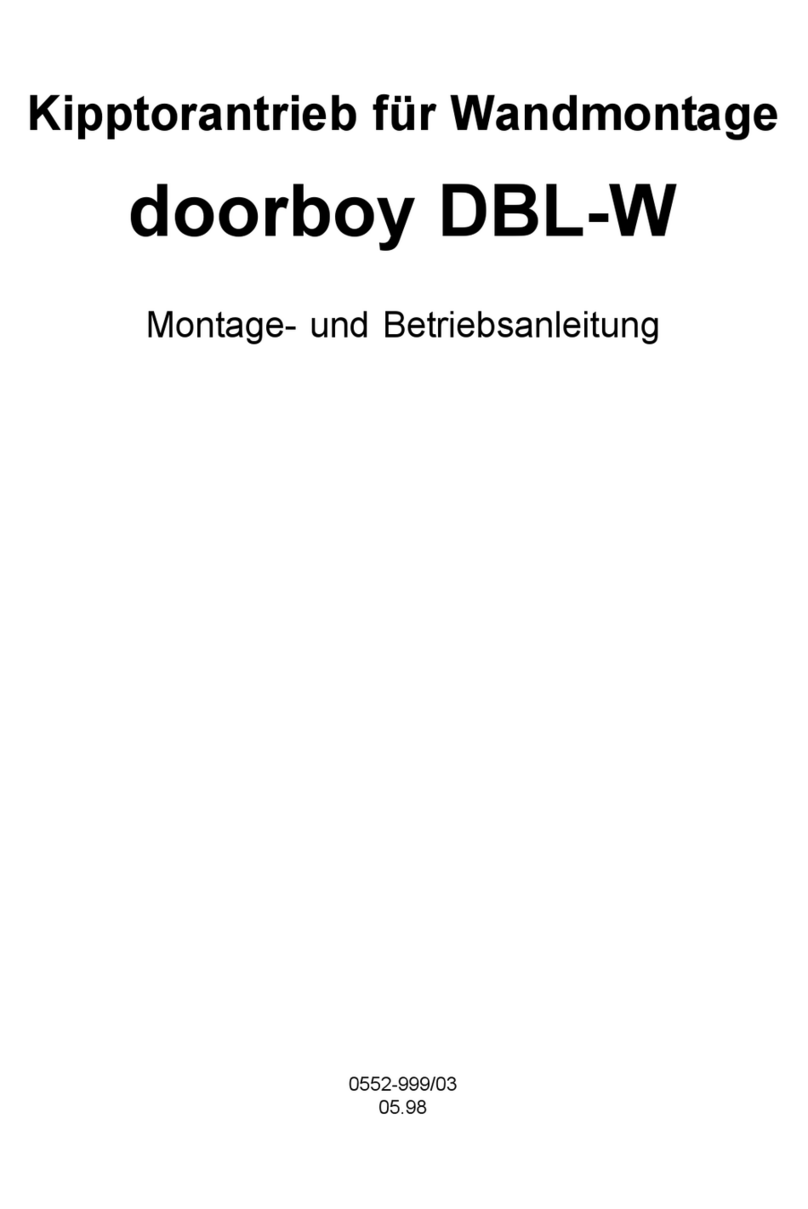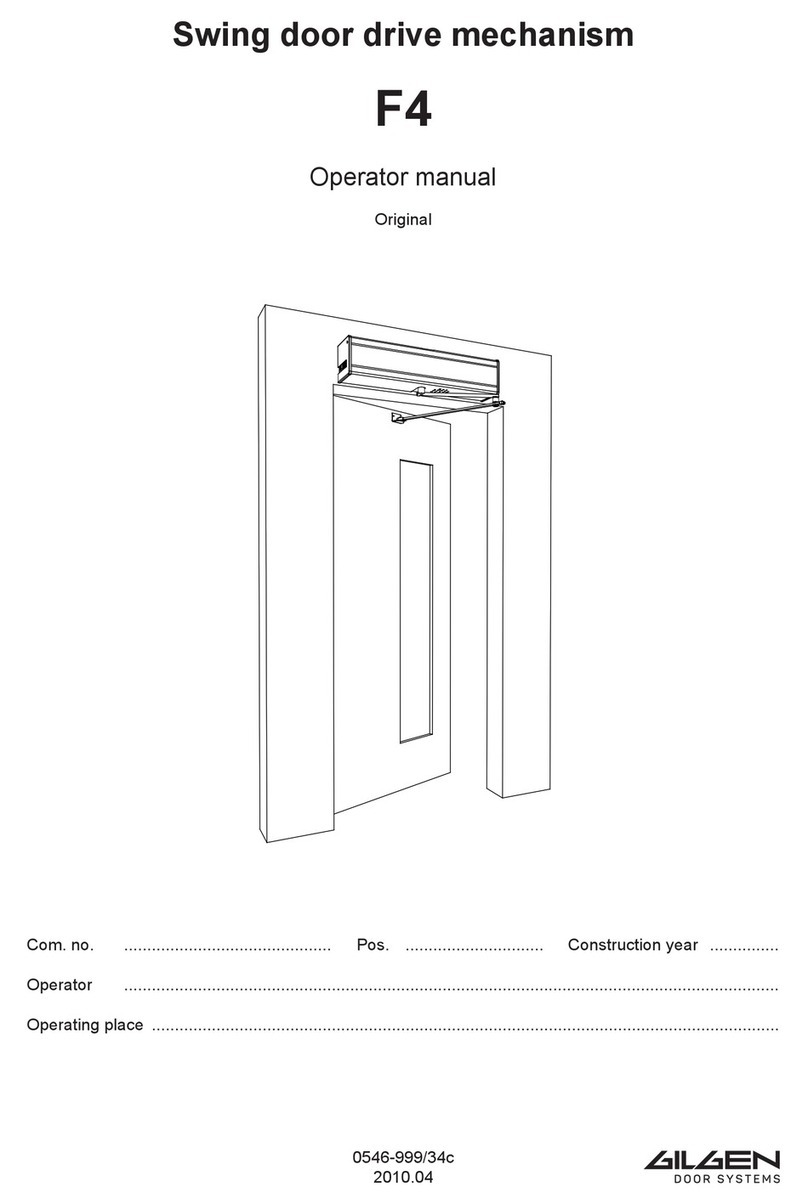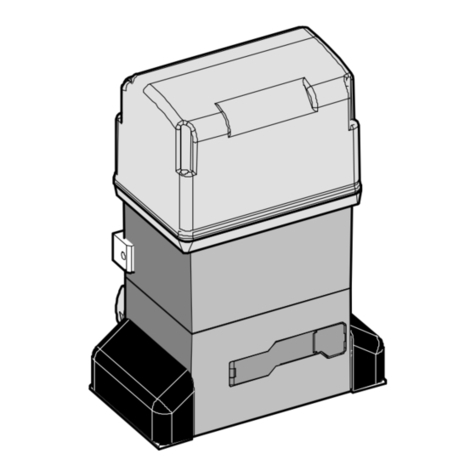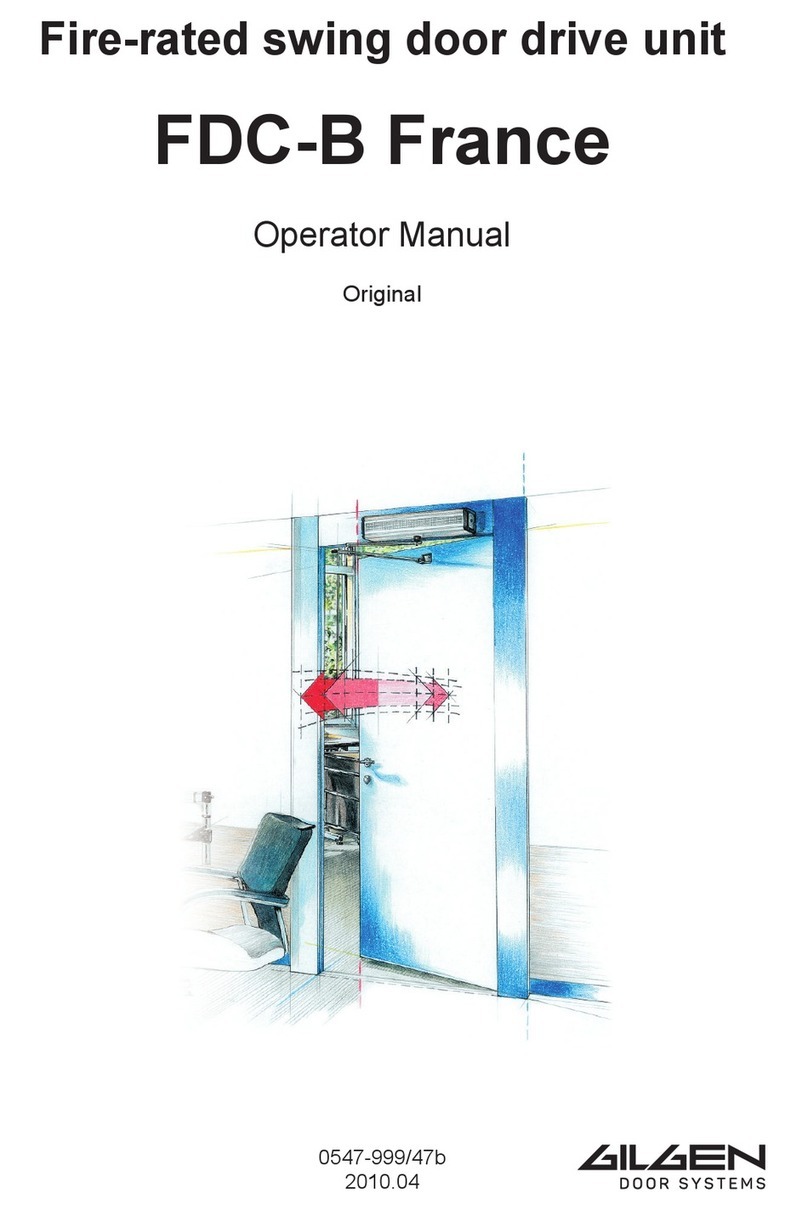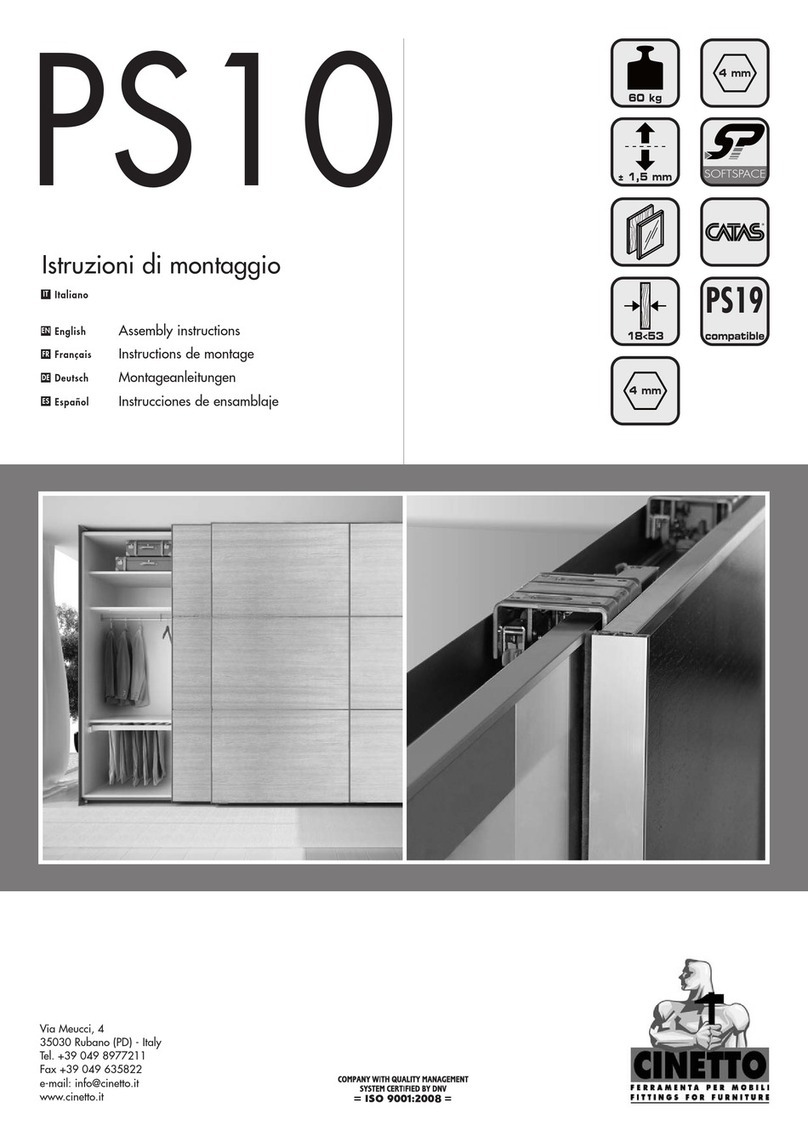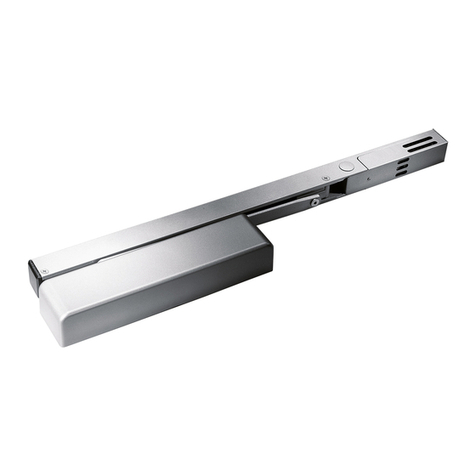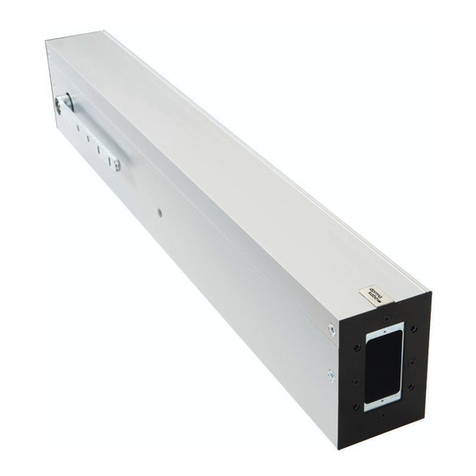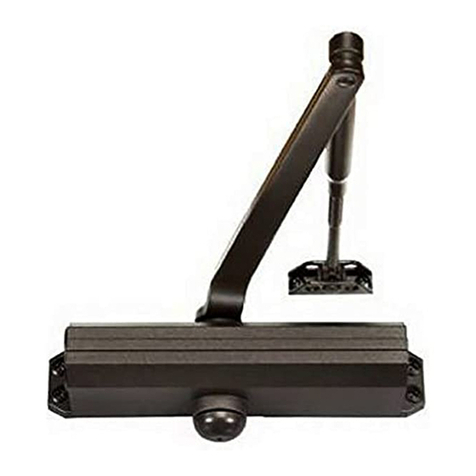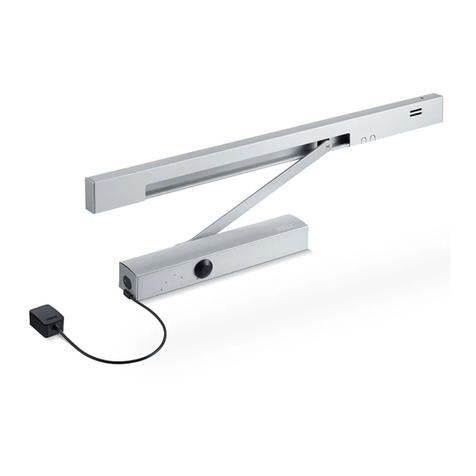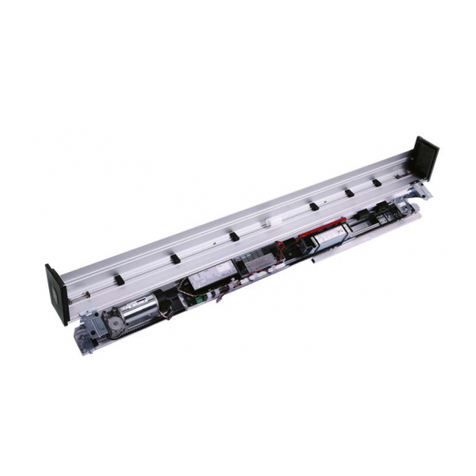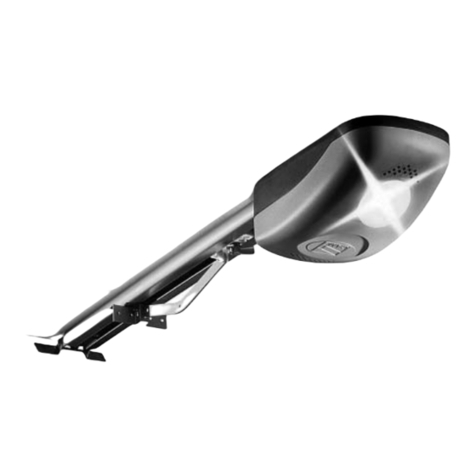GILGEN SLM User manual

0630-999-22b_2004.12.p65 0630-999/22b
SLM
1-8
DE
SLM SWING-OUT
Note:
All the installation work has been carried out
according to the assembly instructions 0630-999/
11(uptochapter3.1inclusive.)Thefloorguideway
has been installed according to the respective
application sheet P.
1 Installation wall connection profile
Mount the wall connection profile according to the respective
application drawing P 6.6.1, P 6.6.2 or P 6.6.3
2 Installation of side panels
Version A
1. See next page.
Version B
1. Mount the side panels according to application drawing
P 08.06.01.
2. Connection of the swing-out monitoring device (monitoring
light barrier) to the control according to diagram E4-0141-013
in the appendix.
Version C (without side panel)
1. Connection of the swing-out monitoring device (monitoring
light barrier) to the control according to diagram E4-0141-013
in the appendix.
SLM SWING-OUT
Hinweis:
AlleMontagearbeitenwurdengemässderMontage-
anleitung 0630-999/11 (bis und mit Kapitel 3.1)
ausgeführt. Die Bodenführung wurde gemäss ent-
sprechendem P-Massblatt gesetzt.
1 Montage Maueranschluss-Profil
MaueranschlussprofilgemässentsprechendemMassblattP 6.6.1,
P 6.6.2 oder P 6.6.3 montieren.
2 Montage Seitenteile
Variante A
1. Siehe nächste Seite.
Variante B
1. Seitenteile gemäss Massblatt P 08.06.01 montieren.
2. Anschliessen der Ausschwenküberwachung (Überwa-
chungslichtschranke) an die Steuerung gemäss Schema E4-
0141-013 im Anhang.
Variante C (ohne Seitenteil)
1. Anschliessen der Ausschwenküberwachung (Überwa-
chungslichtschranke) an die Steuerung gemäss Schema E4-
0141-013 im Anhang.
Varianten / Versions
ABC
mit Seitenteil ausschwenkbar mit Seitenteil fest ohne Seitenteil
with swing-out side panel with fixed side panel without side panel

0630-999-22b_2004.12.p65 0630-999/22b
SLM
2-8
DE
4
63
1
Y
LW
LW / 2 LW / 2
5
3
1
2
8
Variante A
1. Seitenteil (1) in Trägerprofil (2) einhängen.
2. Seitenteil (1) durch leichtes Eindrehen der Blechschrauben
inkl. Unterlagsscheiben (3) sichern.
3. Seitenteil (1) nach aussen in das Maueranschlussprofil (4)
schieben.
4. Horizontalprofile (5) im Türlicht montieren.
5. Seitenteiltragprofil (6), inkl. eingebautem Schnäpper und
Magnetendschalter, montieren.
6. Seitenteil(1)aufAnschlaggegenSeitenteiltragprofil(6)schie-
ben.
7. Blechschrauben (3) festziehen.
LW = Lichte Weite
Y = Mitte Bodenführung
Version A
1. Hang up the side panel (1) into the supporting profile (2).
2. Secure the side panel (1) by slightly tightening the tapping
screws including the washers (3).
3. Pushthesidepanel(1)outwardintothewallconnectionprofile
(4).
4. Mountthehorizontalprofiles(5)withintheclearanceopening.
5. Mount the side panel carrying profile(6) including the built-in
spring-loaded catch and magnetic limit stop switch.
6. Pushtheside panel (1) towards thesidepanelcarryingprofile
(6) until it meets the stop piece.
7. Tighten the tapping screws (3).
LW = Clearance opening
Y = Center of floor guideway

0630-999-22b_2004.12.p65 0630-999/22b
SLM
3-8
DE
15 14 13 16 17
11
12
1
8/9
7
10
8
8. Seitenteile (1) unten auf vorgegebene Lichte Weite LW ein-
stellen und Lagerwinkel (7) mittels Senkschraube (8) und
Senk-Unterlagsscheibe(9)aufBodenführung(10)festschrau-
ben.
9. Zylinderschraube (11) mit U-Scheibe und Distanzrohr (12)
entfernen (Transportsicherung).
10. KontrollierenobSeitenteil(1)obenimLotundaufvorgegebe-
nerLichtenWeiteLWist. Falls notwendig, wiefolgteinstellen:
· Zylinderschrauben In-6kt (13) sowie Gegenmutter (14) lö-
sen.
· Mittels Gewindestift (15) Seitenteil oben einstellen.
· Gegenmutter(14)undZylinderschrauben(13)wiederfest-
ziehen.
11. AbstandSeitenteil(1)zu Bodenführung(10)auf8mmeinstel-
len:
· Gegenmutter (16) lösen und mittels 6kt-Mutter (17)
Abstand einstellen.
· Gegenmutter (16) wieder festziehen.
Kontrolle: Seitenteil (1) darf beim Ausschwenken nicht am
Trägerprofil streifen!
12. Alle elektrischen Kabel in Antriebskasten ziehen und an
Steuerung gemäss Schema anschliessen.
Zusätzlich die Ausschwenküberwachung (Reedkontakt)
gemäss Schema E4-0141-013 im Anhang anschliessen.
13. Öffnungskraft zum Ausschwenken der Seitenteile prüfen und
einstellen. Vorgehen: siehe Kapitel 5.
14. Abdeckbleche über Swing-Out-Beschlag und Tragprofilstück
montieren.
8. Adjust the bottom of the side panels (1) with regard to the
existingclearancewidth(LW)and screw the supportingangle
(7) down to the floor guideway (10), using the flat head screw
(8) and the conical washer (9).
9. Remove the cheese-head screw (11)with thewasher andthe
distance tube (12) (transport protection).
10. Check if the upper part of the side panel (1) is perpendicular
and adjusted to the existing clearance width LW. If required
adjust as follows:
· Unscrewthe hexagon socket cheese-head screws(13) as
well as the counter-nut (14).
· Bymeans of the set screw (15) adjust the upperpart of the
side panel.
· Retighten counter-nut (14) and the cheese-head screws (13).
11. Adjust a distance of 8 mm between the side panel (1) and the
floor guideway (10).
· Loosen the counter-nut (16) and adjust the distance by
means of the hexagon nut (17).
· Retighten the counter-nut (16).
Checking:During the swing-out motion, the side panel (1)
must not brush against the supporting profile!
12. Lay out all the electric cables in the drive case and connect
them to the control according to the diagram.
In addition, connect the swing-out monitoring (Reed contact)
according to diagram E4-0141-013 in the appendix.
13. Check and adjust the opening force for swinging out the side
panels. Procedure: see chapter 5.
14. Mountthesheetmetalcoveringsontopofthe swing-out fitting
and of the supporting profile section.

0630-999-22b_2004.12.p65 0630-999/22b
SLM
4-8
DE
1
2
3
1
23
4
6
5
4
6
5
3 Montage Schiebeflügel
1. Wenn vorhanden, Seitenteil ausschwenken.
2. SchiebeflügelmiteingeschwenktemSwing-Out-Beschlagun-
ter die Laufwagen führen und in die Bodenführung absenken.
3. Distanzplatte (1) zwischen Laufwagen (2) und Schiebeflügel
(3) schieben.
4. Schiebeflügelmittels6kt-SchraubenundNutensteine,gemäss
KIT-InstallationszeichnungB3-0630-030,amLaufwagenfest-
schrauben.
5. Schiebeflügel am Laufwagen einstellen:
Distanz zwischen Bodenführung und Schiebeflügel = 8 mm.
Hinweis:
Zur Schiebeflügelmontage muss auch Kapitel 3.1
der Montageanleitung 0630-999/11 befolgt wer-
den!
4 Schiebeflügel-Vorspannung ein-
stellen
1. Schiebeflügel (1) an Vorderkante ca. 20 mm aus Schnapp-
verhakungschwenken. Je nachFlügelgewicht, senkt sichder
Flügel ab.
2. Lösen der beiden 6kt-Schrauben (2).
3. Mittels Gewindestift (3) die Vorspannung des Schiebeflügels
(1) so einstellen, dass der Bügel (4) beim Einschwenken des
Schiebeflügels (1) auf den Tragwinkel (5) gleitet, ohne dabei
den Flügel anzuheben.
4. 6kt-Schrauben (2) wieder festziehen.
3 Installation of sliding wings
1. Swing out any existing side panel.
2. Guide the sliding wing with swing-out fitting in withdrawn
positionbelowthetravellingcarriagesandloweritintothefloor
guideway.
3. Pushthe distance plate(1)between the travellingcarriage(2)
and the sliding wing (3).
4. Using the hexagon head cap screws and the sliding nuts,
screwtheslidingwingagainstthetravellingcarriageaccording
to installation drawing B3-0630-030.
5. Adjustingtheslidingwingonthetravellingcarriage:Keepadistance
of 8 mm between the floor guideway and the sliding wing.
Note:
When mounting the sliding wings, also take into
account chapter 3.1 of the assembly instructions
0630-999/11!
4 Adjusting the prestressing of
sliding wings
1. Swing the leading edge of the sliding wing (1) approx. 20 mm
outofthe snap-in interlocking. Dependingonthe wing weight,
this will cause the wing to be lowered.
2. Loosen both hexagon head cap screws (2).
3. By means of the set screw (3) adjust the prestressing of the
sliding wing (1) in such a manner that when the wing (1) is
swung back the strap (4) glides onto the supporting angle (5)
without lifting the sliding wing.
4. Retighten the hexagon head cap screws (2).
Drehpunkt
Pivot

0630-999-22b_2004.12.p65 0630-999/22b
SLM
5-8
DE
2
1
4
3
max. 105° max. 105°
5 Kontrolle der Ausschwenkkräfte
Warnung:
Die Öffnungskraft zum Ausschwenken der Seiten-
teileundSchiebeflügeldarfhöchstens150Nbetra-
gen.
Die Öffnungskraft ist rechtwinklig zum Seitenteil
oder Schiebeflügel an der dem Drehpunkt gegen-
überliegendenSeite (1 m ab Boden) mittels Feder-
waage zu messen.
Bei Auslieferung der Anlage sind Schnäpper (1) im Seitenteil und
Schnappverhakung(3)imSchiebeflügelaufeineNenn-Öffnungs-
kraft voreingestellt. Wenn erforderlich, ist die Öffnungskraft wie
folgt zu korrigieren:
Seitenteil
Einstellen der Öffnungskraft am Gewindestift (2) im Schnäp-
per (1): Drehen im Uhrzeigersinn = Krafterhöhung.
Schiebeflügel
Einstellen der Öffnungskraft am Gewindestift (4) in der Schnapp-
verhakung (3): Drehen im Uhrzeigersinn = Krafterhöhung.
6 Bauseitige Anschläge kontrollieren
Achtung:
BauseitigmüssenfesteAnschlägevorhandensein,
die verhindern, dass die Seitenteile mehr als 105°
geöffnet werden können.
5 Checking the swing-out forces
Warning:
The force required for swinging out the side panels
and the sliding wings must not exceed
150 N.
The opening force must be measured by means of
aspringbalanceappliedperpendicularlytotheside
panelortheslidingwing,ontheoppositesideofthe
pivot (at a height of 1 m from floor level).
Upon delivery of the installation the spring-loaded catch (1) in the
sidepaneland the snap-ininterlocking (3) inthesliding wing have
been preset to a reference opening force. If required this opening
force can be corrected as follows:
Side panel
Adjustment of the opening force by means of the set screw (2) in
the spring-loaded catch (1): Turning the screw clockwise = the
force is increased.
Sliding wings
Adjustment of the opening force by means of the set screw (4) in
the snap-in interlocking (3): Turning the screw clockwise = the
force is increased.
6 Checking the stop pieces
(suppliedbycustomer)
Attention:
Fixed stop pieces must be provided by customer
in order to prevent an opening of the side panels
which exceeds 105°.
Anschlag bauseits Stop piece
by customer

0630-999-22b_2004.12.p65 0630-999/22b
SLM
6-8
DE
0460-794
1'317
1'400
7 Break-Out-Kleber
JedeSwing-Out-SchiebetürmitFluchtwegfunktionmussinFlucht-
richtung mit den Break-Out-Klebern 0460-794 gekennzeichnet
werden.
Falls nicht bereits ab Werk aufgeklebt, sind die mitgelieferten
Break-Out-Kleber (in Fluchtrichtung) wie abgebildet aufzukleben.
7 Break-Outsticker
Every Swing-Out sliding door fulfilling an escape way function
must be identified in the escape way direction by means of the
Break-Out stickers 0460-794.
Unlessthey have already been attached at the factory, theBreak-
Out stickers included in the delivery must be affixed (in the
escape way direction) as illustrated.

0630-999-22b_2004.12.p65 0630-999/22b
SLM
7-8
DE
8 Option
Ausschwenkverriegelung mit
Überwachung VERI-SO-UE
Funktion
Die Ausschwenkverriegelung verhindert das Ausschwenken der
Türflügel, das heisst: keine Swing-Out Funktion (Nachtbetrieb).
Im Tagbetrieb müssen die Hebel immer auf Entriegelt gestellt
werden.
Um sicher zu stellen, dass die Hebel im Tagbetrieb auf Entriegelt
gestellt sind, wird die Option Überwachung UE eingebaut. Wird
die Ausschwenkverriegelung im Tagbetrieb nicht auf Entriegelt
gestellt, läuft die Tür immer auf und zu. Dadurch wird signalisiert,
dass die Swing-Out Funktion nicht möglich ist.
Die Hebel können mittels Option VERI-SO-ZUE abgeschlossen
werden.
8 Option
Swing-out disabling with
monitoring VERI-SO-UE
Function
Inthelockedposition,theswing-outdisablingfeaturepreventsthe
door wings from being swung out, which means: no swing-out
function (operating mode Night). During the operating mode Day,
the levers must always be set to the unlocked position.
In order to ensure that the levers are set to the unlocked position
during the operating mode Day, the option Monitoring UE is
installed. If in the operating mode Day the swing-out disabling
featureis notset to Unlocked, the door will continuously open and
close, in order to draw the attention to the fact that the Swing-out
function is not possible.
The levers can be locked by means of the option VERI-SO-ZUE.
Ausschwenkverriegelung verriegelt
Swing-out disabling feature locked
Ausschwenkverriegelung entriegelt
Swing-out disabling feature unlocked

0630-999-22b_2004.12.p65 0630-999/22b
SLM
8-8
DE
max. 30,5
5
4
32
1
VERI-S
9 Anhang
Schema................................................................... E4-0141-013
Änderungen vorbehalten / Masse in mm
9 Appendix
Diagram..................................................................E4-0141-013
Modifications reserved / Measures in mm
Material
Set Kremonenstangenüberwachung 0620-882/90
1 Halteblech zu Reedsensor 0620-875
2 Reedsensor 6451-201
Montage
1. Halteblech (1) mittels Schrauben (2) an Verriegelung befesti-
gen.
2. Reedsensoren (3) am Haltblech (1) befestigen.
3. Reedsensorkabel an die Steuerung (KLESE) auf Klemmen 8
und 10 (OKA) anschliessen.
4. ÜberdievertikalenLanglöcherimHalteblech(1)Reedsensoren
(3) so einstellen, dass diese ein Signal abgeben, sobald die
Schliessbolzen (4) im Abdeckprofil (5) eingreifen.
Material
Set Staybar monitoring 0620-882/90
1 Support plate for Reed sensor 0620-875
2 Reed sensor 6451-201
Installation
1. Using the screws (2), fasten the support plate (1) onto the
locking mechanism.
2. Fasten the Reed sensors (3) on the support plate (1)
3. Connect the Reed sensor cable to the control (KLESE), on
terminals 8 and 10 (OKA).
4. By means of the vertical slots in the support plate (1), adjust
the Reed sensors (3) in such a manner that they generate a
signal as soon as the locking bolts (4) are locking into the
covering profile (5).
Zylinder-Fabrikat Bestell-Nr.
Cylinder brand Ordering no.
KABA GEMINI 1414
DOM 333H ix-5
ZEISS-IKON 0040
System TK5 (L = 40 mm) 5040
5532 SST = 8 x 45
5532 SST = 30
5532 SST = 8 x 30
KESO 21.214.040
BKS 3101 NBL27
3301 NBL27
8900 NBL27
VERI-SO-ZUE
Es kann aus nachfolgenden Profilzylinder-Typen (Halbzylinder)
ausgewählt werden. Deren Lieferung erfolgt bauseits.
VERI-SO-ZUE
Any of the following profile cylinders (half cylinders) can be
selected. They will be supplied by customer.





0630-999-22b_2004.12.p65 0630-999/22b
SLM
1-8
FI
SLM SWING-OUT
Nota:
Tutti i lavori di montaggio sono stati effettuati
secondo le istruzioni di montaggio 0630-999/11
(sino al capitolo 3.1 incluso). La guida a pavimento
è stata inserita secondo il corrispondente foglio
applicativo P.
1 Montaggio del profilo di
collegamento a muro
Montare il profilo di collegamento a muro secondo il disegno
applicativo corrispondente P 6.6.1, P 6.6.2 o P 6.6.3.
2 Montaggio dei pannelli laterali
Variante A
1. Vedere la pagina successiva.
Variante B
1. Montare i pannelli laterali secondo il disegno applicativo
P 08.06.01.
2. Collegamento della sorveglianza del dispositivo anti-panico
(barriera luminosa di monitoraggio) all’unità di controllo
secondo lo schema E4-0141-013 nell’appendice.
VarianteC(senzapannellolaterale)
1. Collegamento della sorveglianza del dispositivo anti-panico
(barriera luminosa di monitoraggio) all’unità di controllo
secondo lo schema E4-0141-013 nell’appendice.
SLM SWING-OUT
Remarque:
Tous les travaux de montage ont été exécutés
suivant les instructions de montage 0630-999/11
(jusqu’auchapitre3.1ycompris).Leguidageausol
a été posé selon la tabelle cotée respective.
1 Montage profil de raccordement
mural
Monterleprofilderaccordementmuralsuivantlestabellescotées
P 6.6.1, P 6.6.2 ou P 6.6.3.
2 Montage parties latérales
Variante A
1. Voir page suivante
Variante B
1. MonterlespartieslatéralessuivantlatabellecotéeP08.06.01.
2. Raccordement de la surveillance du dispositif anti-panique
(rayonlumineuxdesurveillance)àlacommandeselonschéma
E4-0141-013 en annexe.
Variante C (sans partie latérale)
1. Raccordement de la surveillance du dispositif anti-panique
(rayonlumineuxdesurveillance)àlacommandeselonschéma
E4-0141-013 en annexe.
Varianti /Versions
ABC
avec partie latérale éclipsable avec partie latérale fixe sans partie latérale
con il pannello laterale girevole con il pannello laterale fisso senza il pannello laterale

0630-999-22b_2004.12.p65 0630-999/22b
SLM
2-8
FI
4
63
1
Y
LW
LW / 2 LW / 2
5
3
1
2
8
Variante A
1. Accrocher la partie latérale (1) dans le profil portant (2).
2. Bloquer la partie latérale (1) en serrant légèrement les vis à
tôle y compris les rondelles (3).
3. Pousser la partie latérale (1) vers l’extérieur dans le profil de
raccordement mural (4).
4. Monter les profils horizontaux (5) dans l’embrasure.
5. Monter le profil de support de la partie latérale (6) y compris
leverrouàressortetl’interrupteurdefin-de-coursemagnétique.
6. Pousser la partie latérale (1) contre le profil de support de la
partie latérale (6) jusqu’à la butée d’extrémité.
7. Serrer les vis à tôle (3).
LW = Largeur libre
Y = Centre guidage au sol
Variante A
1. Agganciare il pannello laterale (1) nel profilo portante (2).
2. Assicurare il pannello laterale (1) mediante leggero serraggio
delle viti per lamiera con le rondelle (3).
3. Spingere il pannello laterale (1) nel profilo di collegamento a
muro (4) verso l’esterno.
4. Montare i profili orizzontali (5) nella luce della porta.
5. Montareilprofiloportantepartelaterale(6),inclusiilchiavistello
e l’interruttore magnetico di fine corsa montati.
6. Spingere il pannello laterale (1) sull’arresto contro il profilo
portante del pannello laterale (6).
7. Serrare le viti per lamiera (3).
LW = Larghezza della luce
Y = Centro guida a pavimento

0630-999-22b_2004.12.p65 0630-999/22b
SLM
3-8
FI
15 14 13 16 17
11
12
1
8/9
7
10
8
8. Ajuster les parties latérales (1) en bas par rapport à la largeur
libre disponible (LW) et visser l’équerre d’appui (7) contre le
guidage au sol (10), en utilisant la vis à tête fraisée (8) et la
rondelle conique (9).
9. Démonter la vis à tête cylindrique (11) avec la rondelle et le
tubed’écartement(12)(dispositifdesécuritépourletransport).
10. Contrôler si la partie latérale (1) est bien à plomb et adjustée
àlalargeurlibreLWrespective.Sinécessairerajustercomme
suit:
· Desserrer les vis à tête cylindrique à 6 pans creux (13)
ainsi que le contre-écrou (14)
· Moyennant la vis sans tête (15), régler partie latérale en
haut.
· Resserrer le contre-écrou (14) et les vis à tête §
cylindrique (13).
11. Régler une distance de 8 mm entre la partie latérale (1) et le
guidage au sol (10):
· Desserrer le contre-écrou (16) et régler la distance
moyennant l’écrou hexagonal (17).
· Resserrer le contre-écrou (16).
Contrôle: Lors du débattement vers l’extérieur, la partie
latérale (1) ne doit pas frotter contre le profil portant!
12. Poser tous les câbles électriques dans le caisson
d’entraînement et les raccorder à la commande suivant le
schéma. En plus, raccorder la surveillance du dispositif anti-
panique(contactReed)selonschémaE4-0141-013enannexe.
13. Contrôler et régler la force d’ouverture pour le débattement
des parties latérales. Procédure: voir chapitre 5.
14. Monter les tôles de recouvrement au-dessus de l’accessoire
anti-panique et de la pièce du profil de support.
8. Regolare i pannelli laterali (1) in basso in base alla larghezza
della luce prefissato LW ed avvitare l’angolo di supporto (7)
mediante la vite a testa svasata (8) e la rondella svasata (9)
sulla guida a pavimento (10).
9. Togliere la vite a testa cilindrica (11) con la rondella e con il
tubo distanziale (12) (bloccaggio per il trasporto).
10. Controllare se il pannello laterale (1) in alto è a piombo e
regolato in base alla larghezza della luce prefissato LW. Se
necessario, regolare come segue:
· Allentare le viti a testa cilindrica a cava esagonale (13) ed
il controdado (14).
· Regolare il pannello laterale superiore mediante il perno
filettato (15).
· Serrare nuovamente il controdado (14) e le viti a testa
cilindrica (13).
11. Regolare il pannello laterale (1) ad una distanza di 8 mm
rispetto alla guida a pavimento (10):
· Allentareilcontrodado(16)eregolareladistanzamediante
il dado esagonale (17).
· Serrare nuovamente il controdado (16).
Controllo: Durante la rotazione la parte laterale (1) non deve
strisciare sul profilo portante!
12. Togliere tutti i cavi elettrici nella copertura dell’automazione e
collegarli sull’unità di controllo secondo lo schema.
Inoltre collegare il monitoraggio di apertura (contatto Reed)
secondo lo schema E4-0141-013 in appendice.
13. Controllare e regolare la forza di apertura per il moto di
rotazione dei pannelli laterali. Procedura: vedere il capitolo 5.
14. Montare le lamiere di copertura sulla guarnitura dello swing-
out e sulla sezione di profilo portante.

0630-999-22b_2004.12.p65 0630-999/22b
SLM
4-8
FI
1
2
3
1
23
4
6
5
4
6
5
3 Montage des vantaux coulissants
1. Débattre vers l’extérieur une partie latérale évent. existante.
2. Amener le vantail coulissant avec l’accessoire anti-panique en
positionrentréen-dessousdeschariotsderoulementetledescendre
dans le guidage au sol.
3. Glisserlaplaqued’écartement(1)entrelechariotderoulement(2)
et le vantail coulissant (3).
4. En utilisant les vis à tête hexagonale et les coulisseaux, visser le
vantail coulissant contre le chariot de roulement, selon dessin
d’installation KIT B3-0630-030.
5. Réglageduvantailcoulissantsurchariotderoulement:Ladistance
entre le guidage au sol et le vantail coulissant doit être de 8 mm
Remarque:
Lors du montage des vantaux coulissants, il faut
également tenir compte du chapitre 3.1 des
instructions de montage 0630-999/11!
4 Régler la précontrainte du vantail
coulissant
1. Pivoter la tranche du vantail coulissant (1) de manière à ce
qu’elle sorte d’environ 20 mm de l’accrochage à
loqueteau.Suivant le poids du vantail, ce dernier s’abaisse.
2. Dévisser les deux vis à tête hexagonale (2).
3. Moyennant la vis sans tête (3), régler la précontrainte du van-
tail coulissant (1) de façon à ce que, lorsque ce dernier est
pivotéversl’intérieur,l’étrier(4)glissesurl’équerredesupport
(5) sans que ceci ait pour effet de soulever le vantail.
4. Resserrer les vis à tête hexagonale (2).
Axe de rotation
Punto di rotazione
3 Montaggio del battente scorrevole
1. Far ruotare il pannello laterale eventualmente esistente.
2. Portareilbattentescorrevoleconlaguarnituradelloswing-out
inposizioneretrattasottoilcarrellodiscorrimentoedabbassarlo
nella guida a pavimento.
3. Spingere la piastra distanziale (1) tra il carrello di scorrimento
(2) ed il battente scorrevole (3).
4. Avvitare il battente scorrevole sul carrello di scorrimento con
vitiesagonali ed elementi scanalati, secondo il disegnodel kit
di installazione B3-0630-030.
5. Regolare il battente scorrevole sul carrello di scorrimento:
Distanzatra guidaa pavimento e battente scorrevole = 8 mm.
Nota:
Per il montaggio dell’anta scorrevole si deve
osservare anche il capitolo 3.1 dell’istruzione di
montaggio 0630-999/11 !
4 Regolazione del precarico
dell’anta scorrevole
1. Ruotare il bordo anteriore del battente scorrevole (1) di ca. 20
mm fuori dall’aggancio a scatto. L’anta si abbassa a seconda
del proprio peso.
2. Allentare entrambe le viti esagonali (2).
3. Regolarecosìilprecaricodelbattentescorrevole(1)mediante
il perno filettato (3), in modo che la staffa (4) inserendo il
battente scorrevole (1) scorra sull’angolo di supporto (5),
senza sollevare l’anta.
4. Serrare nuovamente le viti esagonali (2).

0630-999-22b_2004.12.p65 0630-999/22b
SLM
5-8
FI
2
1
4
3
max. 105° max. 105°
5 Contrôle des forces de débattement
Avertissement:
La force nécessaire pour débattre les parties
latéraleset les vantaux coulissantsvers l’extérieur
ne doit pas dépasser 150 N.
Laforce d’ouverture doitêtre mesuréeà l’aide d’un
peson à ressort, appliqué à angle droit par rapport
àlapartielatéraleresp.auvantailcoulissant, sur le
côté opposé à l’axe de rotation (à un niveau d’un
mètre à partir du sol).
Avant la livraison de l’installation, le verrou à ressort (1) dans la
partie latérale et l’accrochage à loqueteau (3) dans le vantail
coulissant ont été ajustés à une force d’ouverture nominale. Si
nécessaire, cette force nominale peut être corrigée comme suit:
Partie latérale
Réglage de la force d’ouverture sur la vis sans tête (2) dans le
verrou à ressort (1):Tourner dans le sens des aiguilles de montre
= augmentation de la force.
Vantail coulissant
Réglage de la force d’ouverture sur la vis sans tête (4) dans
l’accrochage à loqueteau (3): Tourner dans le sens des aiguilles
de montre = augmentation de la force.
6 Contrôler les butées d’extrémité
installées par le commettant
Attention:
Des butées d’extrémité fixes doivent être prévues
parle commettant, afin d’éviter que l’ouverture des
parties latérales dépasse 105°.
5 Controllo delle forze di rotazione
Avvertenza:
La forza di apertura per il moto di rotazione dei
pannellilateraliedeibattentiscorrevolideverisultare
al massimo di 150 N.
Laforzadiaperturadeveesseremisuratamediante
un dinamometro disposto perpendicolarmente
rispettoalpannellolateraleoalbattente scorrevole
sul lato opposto al punto di rotazione (1 m dal
pavimento).
Per la fornitura dell’impianto la chiusura a scatto (1) nel pannello
lateralee l’aggancio ascatto (3) nelbattente scorrevole sonostati
precaricati ad un valore nominale della forza di apertura. Se
necessario,laforzadiaperturadeve essere corretta come segue:
Pannello laterale
Regolazione della forza di apertura sul perno filettato (2) nella
chiusura a scatto (1): rotazione in senso orario = aumento della
forza.
Battente scorrevole
Regolazione della forza di apertura sul perno filettato (4)
nell’aggancio a scatto (3) : rotazione in senso orario = aumento
della forza.
6 Controllo degli arresti (a carico
cliente)
Attenzione:
Devono essere forniti a carico cliente degli arresti
fissi, che evitino che i pannelli laterali possano
essere aperti oltre 105°.
Butée du commettant Arresto
a carico cliente

0630-999-22b_2004.12.p65 0630-999/22b
SLM
6-8
FI
0460-794
1'317
1'400
7 EtichettaBreak-Out
Ciascuna porta scorrevole Swing-Out con funzione uscita di
sicurezza, deve essere identificata nella direziona di fuga con
un'etichetta Break-Out 0460-794.
Se esse non sono ancora incollate alla fabbrica, si deve
incollare le etichette Break-Out (in allegato) come illustrazione.
7 Autocollant "Break-Out"
Chaque porte coulissante Swing-Out avec fonction de passage
defuitedoitêtreidentifiéedanslesensdupassagedefuiteàl'aide
des autocollants "Break-Out" 0460-794.
Amoinsqu'ilsn'aientpasdéjàétéattachésàl'usine,lesautocollants
"Break-Out" inclus dans la livraison doivent être collés (dans le
sens du passage de fuite) comme illustré.

0630-999-22b_2004.12.p65 0630-999/22b
SLM
7-8
FI
8 Option
Verrouillage du dispositif anti-pani-
que avec surveillance VERI-SO-UE
Fonctionnement
Dans l’état verrouillé, le verrouillage du dispositif anti-panique
empêcheundébattementdesvantauxdeporte,cequisignifieque
la fonction swing-out (anti-panique) est désactivée (mode de
fonctionnement Nuit). Dans le mode Jour, les leviers doivent
toujours être placés sur "Déverrouillé".
Afin d’assurer que, dans le mode de fonctionnement Jour, les
leviers se trouvent dans la position déverrouillée, l’option
SurveillanceUEestinstallée.Sidanslemodedefonctionnement
Jour le verrouillage du dispositif anti-panique n’est pas commuté
surDéverrouillé, la portene cessede s’ouvrir etse fermer,afin de
signaler que la fonction Swing-out n’est pas possible.
Les leviers peuvent être verrouillés à l'aide de l'option VERI-SO-
ZUE.
8 Opzione
Chiavistellocondispositivoanti-pa-
nico con sorveglianza VERI-SO-UE
Funzionamento
Nello stato bloccato, il chiavistello con dispositivo anti-panico
impedisce la ruotazione delle ante di porta che significa: nessun
funzionamento Swing-Out (funzionamento Notte). Nel
funzionamentoGiornole leve devonoesseremesse sempre sulla
posizione sbloccata.
Perassicurarechelelevenelfunzionamento Giorno siano messe
nella posizione sbloccata, l’opzione sorveglianza UE viene
installata.SenelfunzionamentoGiornoilchiavistellocondispositivo
anti-panico non è messo sulla posizione sbloccata, la porta non
smettediaprireechiudere.Questasegnalacheunfunzionamento
Swing-Out non è possibile.
Le leve possono essere chiuse con l'aiuto dell'opzione VERI-SO-
ZUE.
Verrouillage du dispositif anti-panique verrouillé
Chiavistello con dispositivo anti-panico bloccato
Verrouillage du dispositif anti-panique déverrouillé
Chiavistello con dispositivo anti-panico sbloccato

0630-999-22b_2004.12.p65 0630-999/22b
SLM
8-8
FI
max. 30,5
5
4
32
1
VERI-S
9 Annexe
Schéma................................................................... E4-0141-013
Sous réserve de changements / Mesures en mm
9 Appendice
Schema................................................................... E4-0141-013
Sottoposto a cambiamenti / Misure in mm
Matériel
Jeu Surveillance de la crémone 0620-882/90
1 Tôle de retenue pour capteur Reed 0620-875
2 Capteurs Reed 6451-201
Montage
1. A l’aide des vis (2), fixer la tôle de retenue (1) contre le
mécanisme de verrouillage
2. Fixer les capteurs Reed (3) sur la tôle de retenue (1).
3. Raccorder les câbles des capteurs Reed à la commande
(KLESE), aux bornes 8 et 10 (OKA).
4. A l’aide des fentes verticales dans la tôle de retenue (1),
ajusterlescapteursReed(3)demanièreàcequecesderniers
émettent un signal dès que les axes de verrouillage (4)
s’engagent dans le profil de rhabillage (5).
Materiale
Set sorveglianza della cremona 0620-882/90
1 Lamiera di fissaggio per sensore Reed 0620-875
2 Sensore Reed 6451-201
Montaggio
1. Fissare lamiera di fissaggio (1) al chiavistello mediante
viti (2).
2. Fissare sensori Reed (3) alla lamiera di fissaggio (1).
3. Collegare cavi Reed alla scheda di comando (KLESE) su
morsetti 8 e 10 (OKA).
4. Con l’aiuto di incavi verticali nella lamiera di fissaggio (1)
aggiustare i sensori Reed in maniera che i cui danno un
segnale, non appena i bulloni di chiusura (4) innestano nel
profilo di copertura (5).
Marque du cylindre No. de commande
Marca del cilindro No. di comanda
KABA GEMINI 1414
DOM 333H ix-5
ZEISS-IKON 0040
System TK5 (L = 40 mm) 5040
5532 SST = 8 x 45
5532 SST = 30
5532 SST = 8 x 30
KESO 21.214.040
BKS 3101 NBL27
3301 NBL27
8900 NBL27
VERI-SO-ZUE
Vous avez le choix entre les cylindres à profil (demi-cylindres)
suivants qui seront livrés par le commettant.
VERI-SO-ZUE
E'possibile di scegliere tra icilindri profilo (semi-cilindri) seguenti,
che vengono forniti dal committente.
Table of contents
Other GILGEN Door Opening System manuals
Popular Door Opening System manuals by other brands

Langer & Laumann
Langer & Laumann TSG Sinus Drive Installation instruction

Chamberlain
Chamberlain LiftMaster Professional RDO800 Series Installation and operating instructions

GoodHome
GoodHome 3663602643159 manual
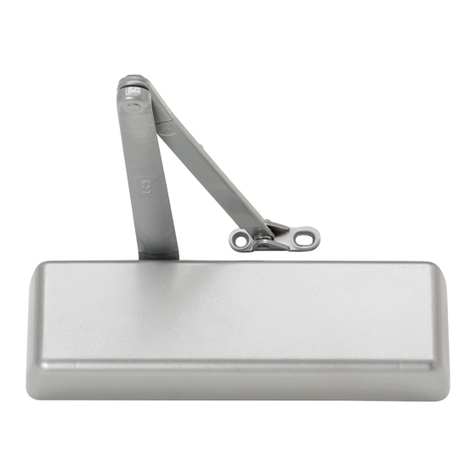
LCN
LCN 4020 Series Product guide
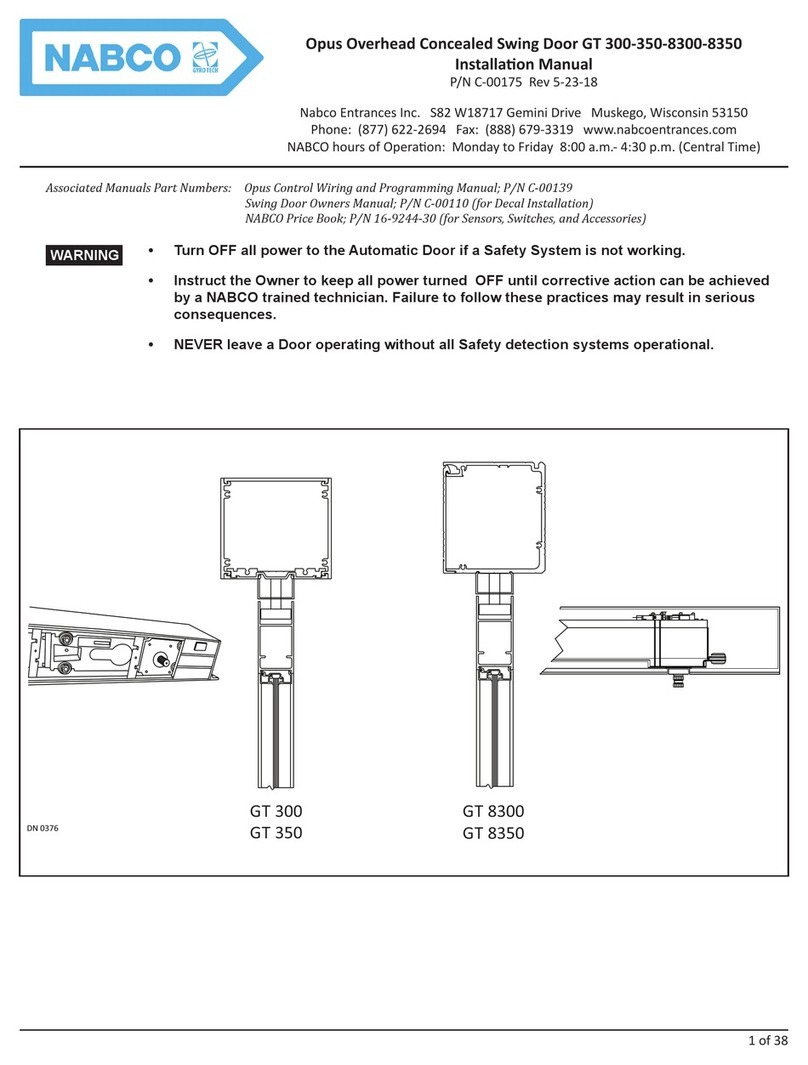
Nabco
Nabco GT 300 installation manual
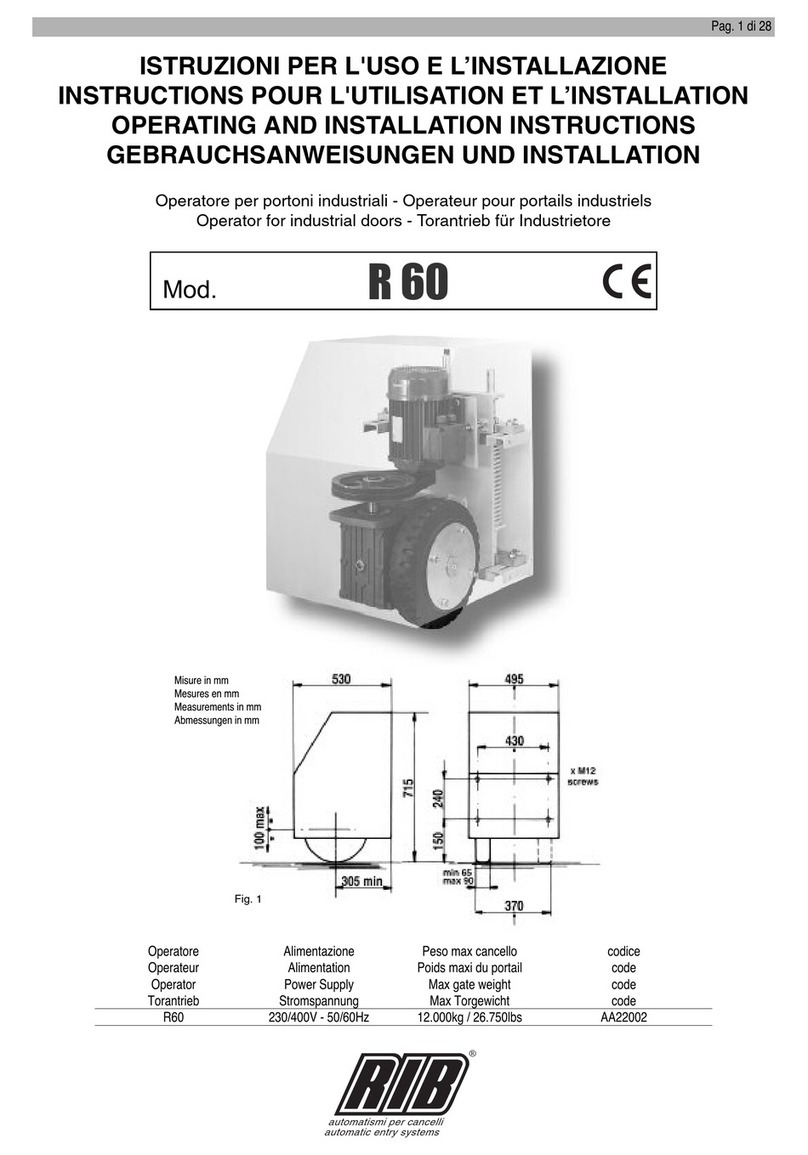
RIB
RIB R60 Operating and installation instructions

